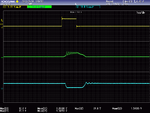nenya
Newbie level 6

Hi,
I'm using the IR2117 driver for the high side MOSFET IRFP450. My switching frequency is 100 kHz and the application is in a buck converter circuit with an input supply of 10 V stepped down to 1 V. I followed the circuit given in the datasheet to test my gate driver. I'm sorry I'm unable to attach the typical connection circuit. I will give the link to the datasheet here.
http://www.irf.com/product-info/datasheets/data/ir2117.pdf
I used a 4.7 microfarad capacitor between Vcc and COM and a 1 microfarad capacitor between Vb and Vs.
I'm giving the logic input to the driver from a function generator. I'm attaching the oscilloscope snapshot of the gate drive input (top trace) and the gate drive output (bottom trace). This is in the buck converter circuit.
Please help me understand why the massive ringing is happening during the switching, and what I can do to eliminate or reduce the severity of the problem. If I have not provided sufficient details please let me know so I can give more details of the circuit. Thanks in advance.
The heavy ringing happens only in the buck converter circuit. When I test only the gate driver circuit connected to just a MOFSET, there is no ringing effect.
I'm using the IR2117 driver for the high side MOSFET IRFP450. My switching frequency is 100 kHz and the application is in a buck converter circuit with an input supply of 10 V stepped down to 1 V. I followed the circuit given in the datasheet to test my gate driver. I'm sorry I'm unable to attach the typical connection circuit. I will give the link to the datasheet here.
http://www.irf.com/product-info/datasheets/data/ir2117.pdf
I used a 4.7 microfarad capacitor between Vcc and COM and a 1 microfarad capacitor between Vb and Vs.
I'm giving the logic input to the driver from a function generator. I'm attaching the oscilloscope snapshot of the gate drive input (top trace) and the gate drive output (bottom trace). This is in the buck converter circuit.
Please help me understand why the massive ringing is happening during the switching, and what I can do to eliminate or reduce the severity of the problem. If I have not provided sufficient details please let me know so I can give more details of the circuit. Thanks in advance.
The heavy ringing happens only in the buck converter circuit. When I test only the gate driver circuit connected to just a MOFSET, there is no ringing effect.
Attachments
Last edited:




